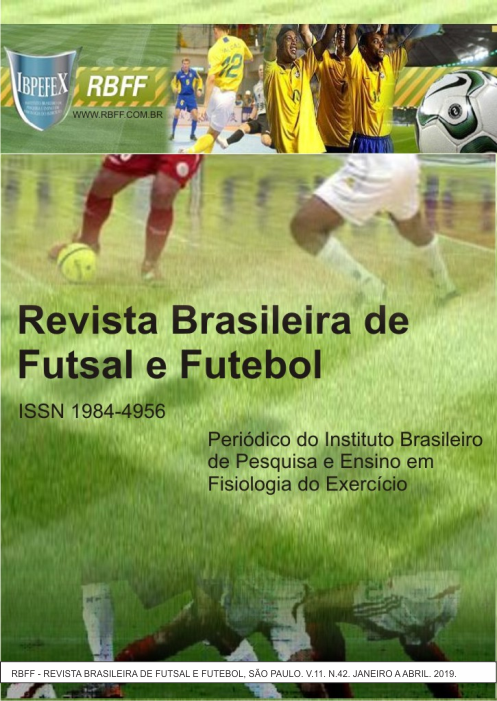Alatical anaerobic power in football players university room
Keywords:
Physical condition assessment, Specific resistance, Alactican aerobic power, FIFA futsal (Mesh)Abstract
Introduction: the evaluation of the physical condition in the sport has now become a fundamental sustaining axis for the control processes in the training. In the same way it is essential that these evaluations are carried out through tests that take into account the specific physiological demand that derives from the futsal, in addition to having scientific criteria of validity, reliability, stability and objectivity the which lead to measuring and assessing the current state of performance of university athletes. Objective: to evaluate the alactic anaerobic power in the players of the university teams of FIFA futsal in the city of San Juan de Pasto (Colombia). Materials and methods: quantitative, cross-sectional descriptive approach with a comparative phase. Wassessed 80 athletes from the FIFA futsal team who participated voluntarily, with informed consent. Results: the average age is 21.58 ± 1.84 years, 73.8% is located in the age range between 21 and 24 years, about half of the athletes with 48.8% is studying between the 4th and 7th semester, in greater proportion have a training frequency of 3 times por week, performing 46.3% as lateral. Conclusion: the majority of the university athletes presented an average level in the alactican aerobic resistance, according to the established classification. Finding that there is a statistically significant association (P = 0.03) when comparing the alactic anaerobic power with maximum oxygen consumption.
References
-Araujo Junior, J. H.; Marques, R. F.; Costa, H. A.; Marques, K. R. M.; de Almeida, R. B.; de Oliveira Júnior, M. N. S. Comparação do teste de rast em jogadores de futebol e futsal de nível universitário. Revista Brasileira de e Prescrição e Fisiologia do Exercício. Vol. 6. Núm.34. p. 367-371. 2012. Disponible en: <http://www.rbpfex.com.br/index.php/rbpfex/article/view/428>
-Andrín, G.G. Caracterización de los esfuerzos en el fútbol sala basado en el estudio cinemático y fisiológico de la competición. Revista digital efdeportes. Buenos Aires. Año. 10. Núm. 77. 2015. Disponible en: <http://www.efdeportes.com/efd77/futsal.htm>.
-Álvarez, M.J.; Giménez, S.L.; Corona, V.P.; Manonelles, M.P. Necesidades cardiovasculares y metabólicas del fútbol sala: análisis dela competición Apunts. Educación física y deportes. Núm. 67. p. 45-51. 2002.
-Álvarez M.J.; y colaboradores. Perfil cardiovascular en el fútbol sala: Adaptaciones al esfuerzo. Archivos: Medicina del Deporte. 2001.
-Campuzano, L.S. Modificación de los parámetros fisiológicos durante la práctica del fútbol-sala. Revista digital efdeportes. Buenos Aires. Año. 18. Núm. 187. 2013. Disponible en: <http://www.efdeportes.com/efd187/los-parametros-fisiologicos-del-futbol-sala.htm>.
-Guerrero, L.A.; Anores, S.S. Fútbol sala: Tareas significativas para el entrenamiento integrado. España. Gymnos, S.L. 2005.
-Lanza, B.A. Test para el control de la condición física del jugador de fútbol en condiciones especiales. Revista digital efdeportes. Buenos Aires. Año. 10. Núm. 70. 2015. Disponible en: <http://www.efdeportes.com/efd70/test.htm>.
-Medina, E.L.; Lazarde, A.G. Incidencias de la resistencia en el futsal. Revista digital efdeportes. Buenos Aires. Año. 18. Núm. 187. 2013. Disponible en: <http://www.efdeportes.com/efd187/incidencias-de-la-resistencia-en-el-futsal.htm>.
-Rodríguez, F.A. Cuestionario de Aptitud para la Actividad Física (C-AAF). Revista Apunts medicina l'sports. Núm. 31. p. 122-131. 2015.
-Sáenz,G.A. Fútbol sala: Tareas significativas para el entrenamiento integrado. España. Grada Gymnos.2010.
-Santos, D.J.; Moreno, M.A.; Valdivieso, F.N. Diferencias en la capacidad de aceleración en carrera en jugadores de fútbol sala en función de la categoría de juego. Revista digital efdeportes. Buenos Aires. Año. 12. Núm. 116. 2008. Disponible en: <http://www.efdeportes.com/efd116/capacidad-de-aceleracion-en-carrera-en-jugadores-de-futbol-sala.htmConsultado noviembre 04, 2017>.
-Sirvent, J.E.; Garrido, R.P. Valoración antropométrica de composición corporal: Cineantropometría. España. Universidad de alicante. 2009.
-Trujillo,M.F. Propuesta para el entrenamiento de la potencia aeróbica en fútbol. Revista digital efdeportes. Año 12. Núm. 109. 2007. Disponible en: <http://www.efdeportes.com/efd109/propuesta-para-el-entrenamiento-de-la-potencia-aerobica-en-futbol.htm>.
-Wilmore, J.H.; Costill, D.L. Fisiología del esfuerzo y del deporte. Paidotribo. 2016.
Downloads
Published
How to Cite
Issue
Section
License
Authors who publish in this journal agree to the following terms:
- Authors retain the copyright and grant the journal the right of first publication, with work simultaneously licensed under the Creative Commons Attribution License BY-NC which allows the sharing of the work with acknowledgment of the authorship of the work and initial publication in this journal.
- Authors are authorized to enter into additional contracts separately for non-exclusive distribution of the version of the work published in this journal (eg, publishing in institutional repository or book chapter), with acknowledgment of authorship and initial publication in this journal.
- Authors are allowed and encouraged to post and distribute their work online (eg, in institutional repositories or on their personal page) at any point before or during the editorial process, as this can bring about productive change as well as increase impact and impact. citation of published work (See The Effect of Free Access).


